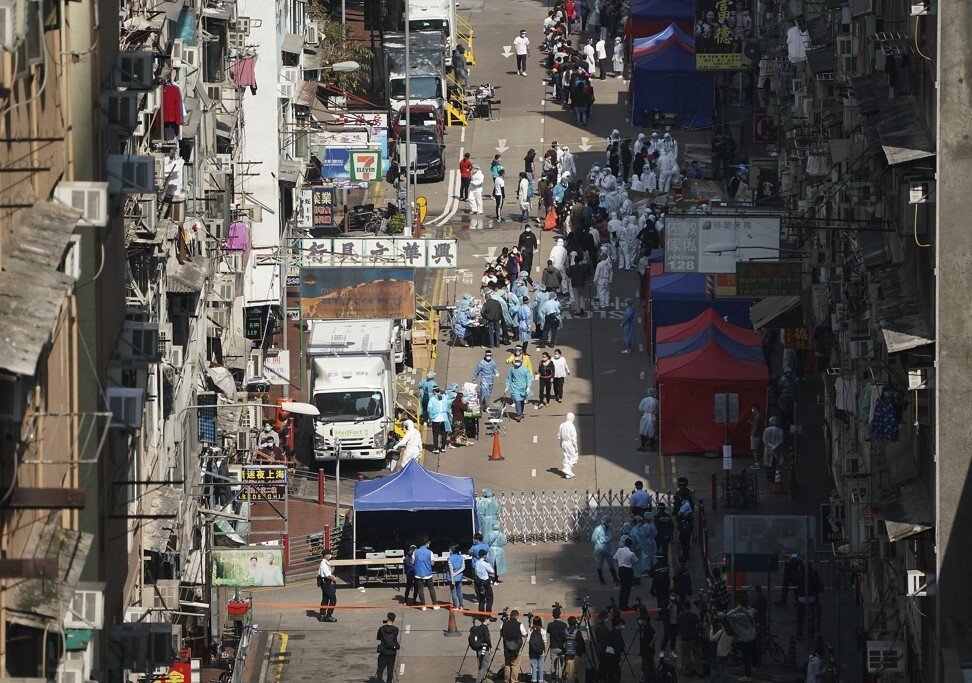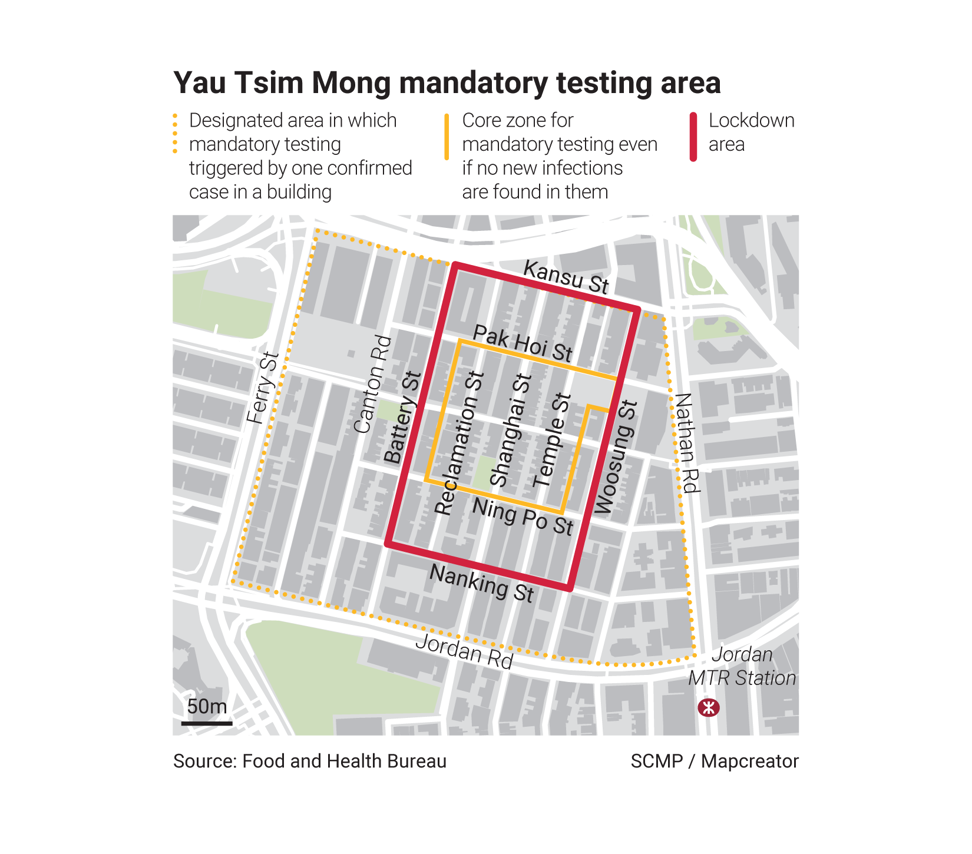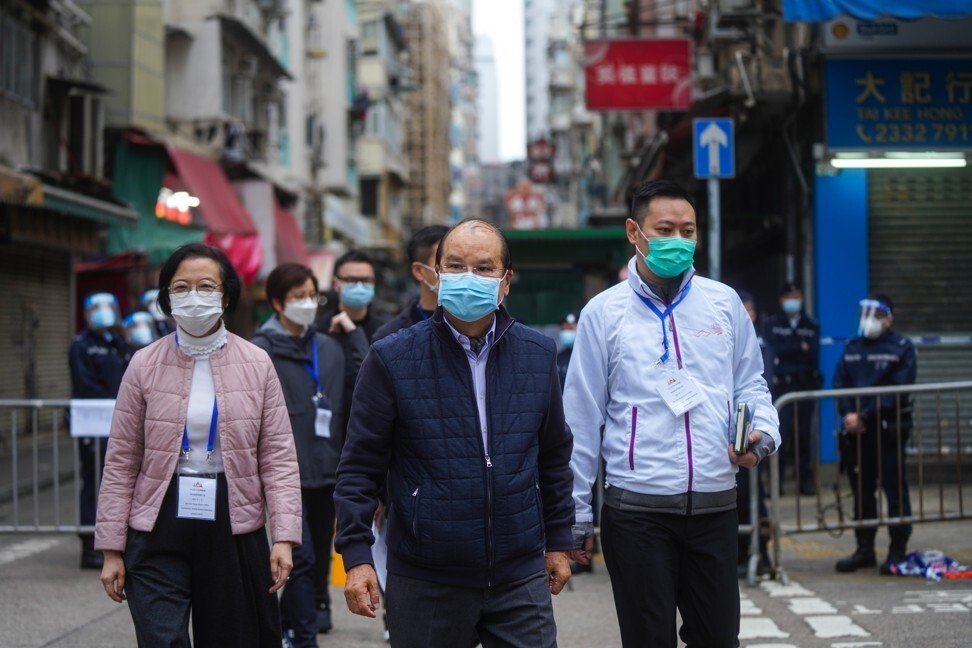The mandatory screening in Jordan uncovered 13 cases, which the health minister says falls in line with broader patterns. Government confident the controversial effort was extensive and the right move.
Hong Kong authorities lifted an unprecedented lockdown of a densely packed neighbourhood in Kowloon shortly after midnight on Sunday after screening most of the 10,000 residents for the coronavirus.
Some people had earlier been allowed to leave the restricted zone in the Jordan neighbourhood of the Yau Tsim Mong district after testing negative for the virus, and police barriers erected around the area were taken down not long after midnight, several hours earlier than planned.
Health workers using mobile testing labs uncovered 13 infections after screening more than 7,000 people since early Saturday. Those cases were not among the 76 new ones confirmed across the city, all but four of which were locally transmitted and 27 untraceable.
The health minister defended the need for the lockdown and dismissed concerns it was an undue hardship on residents given the number of carriers identified, who would be included in Monday’s caseload.
“The positive rate is 0.17 per cent,” Secretary for Food and Health Professor Sophia Chan Siu-chee said. “In fact, if you look at the government testing strategy, which includes compulsory testing, target group testing plus voluntary testing, the overall positive rate is also 0.17 per cent, so it is similar.”
By restricting the movement of residents as screening was carried out, authorities were able to quickly find infected people and isolate them, as well their close contacts, Chan insisted.
“We don’t think this put a heavy burden on people or was a waste of public money,” she said. “This operation was needed.”

While more than 6,900 residents were screened on Saturday, only about 70 were tested on Sunday, according to Secretary for Home Affairs Caspar Tsui Ying-wai. He thanked residents for their cooperation as he announced the operation could end as early as midnight and noted residents who tested negative were allowed to leave beginning at 6pm so long as they wore a simple identifying wristband.
But as of 12.45am, metallic gates were still extended across the two main entry points, while law enforcement were waiting for orders to leave at the junction of Shanghai Street and Kansu Street. Vehicles for road cleaning and garbage collection were allowed to pass into the zone. One resident was seen waiting at an inspection booth with her dog in anticipation of a walk.
It remains unclear how many residents left the area after news of the operation leaked to the media on Friday. Workers visited 3,650 flats and no one answered the door at 470 of them. But Tsui was confident the exercise had been extensive.

“The mobility of the people in the area is rather high,” he said. “Some may have moved elsewhere long before. So, there are vacant units. Some might have been transferred to isolation because they were [previously] confirmed cases. But we will continue following up.”
Authorities had prepared to test at least 10,000 people in the area. Chief Secretary Matthew Cheung Kin-chung said earlier in the day that although the latest government statistics showed about 8,000 people lived in the zone, the figure might be out of date or inaccurate for an area with many transient residents.
Officers sealed off about 200 buildings in the area at 4am on Saturday and deployed roughly 3,000 government workers to carry out the emergency testing in what they planned would be a 48-hour lockdown to cut the chains of transmission in an area blighted by outbreaks. But many residents expressed frustration over how the operation was carried out, complaining not enough warning was given for them to make different arrangements for work. Owners of restaurants and shops have called for compensation to offset the impact of the lockdown on their business.
But Cheung said no financial assistance for individual owners would be offered.
“Employers should also be understanding,” he said. “Do not cut employees’ salary because of this. Do consider allowing them to work from home and asking them to take paid leave … The Labour Department will be helping individual residents in need.”

District councillors also criticised the food arrangements for residents, which included canned meat and dried pasta, saying the government had overlooked the special requirements of elderly residents and the vegetarian diets of some religious members of ethnic minority communities.
The local politicians said authorities should have considered delivering hot dishes, given some older residents had trouble with even basic cooking or lacked a can opener.
Tsui insisted appropriate services were in place for those requiring extra support and added that a hotline had been set up for members of ethnic minority communities.
“For any special cases we will be on the ground to handle them,” he said. “We try to accommodate as best we can and try to shorten the operation so we can allow people to go back to their normal lives as soon as possible,”
Cheung said the entire area would be thoroughly disinfected after the operation was over.
On whether overcrowding in the neighbourhood had contributed to the rise in cases, he conceded the government had to do more to improve urban redevelopment.
“This is an area where building management is less than satisfactory,” Cheung said. “That’s what we are focusing on. Some buildings have no management at all. We have to improve this urban redevelopment. Urban renewal is needed.”
Of the latest citywide cases, six were tied to the restricted zone but were found through methods apart from the screening exercise. Six others were related to Sham Shui Po, where a surge in the number of cases has triggered a mandatory testing order for parts of the district.
Hong Kong has recorded 10,085 confirmed cases, with 169 related deaths. The latest victim was a 72-year-old man who died at Kwong Wah Hospital on Sunday.















